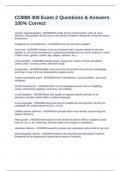COMM 400 Exam 2 Questions & Answers
100% Correct
vocalics (paralanguage) - ANSWERthe study of the communicative value of vocal
behavior, this includes all oral cues in the stream of spoken utterances except the words
themselves.
Categories of Vocal Behavior - ANSWERVoice set and Voice qualities
Voice Set - ANSWER"setting" of an act of speech that is closely related to who the
speaker is. the vocal environment or contextual background is to some measure a result
of their voice. (gender, health, age, fatigue, sadness, etc.)
Voice qualities - ANSWERincludes tempo, resonance, rhythm control, articulation
control, pitch, vocal lip control, and pitch range
Vocalization - ANSWERaudible vocal cues that do not have the structure of language
and may or may not be accompanied by spoken words
Trager vocalization types - ANSWERVocal Characterizer, Vocal Qualifiers, and vocal
seregates
Vocal Characterizer - ANSWERrefers to non-language sounds such as: laughing,
crying, whimpering, giggling, snickering, and sobbing
Vocal Qualifiers - ANSWERthey only qualify or regulate specific portions of an
utterance, provide variety within a spoken language
Vocal segregate - ANSWERvocal cues that are audible but not linguistic; function as
substitutes for verbal utterances (Um, uh-uh)
Unfilled pauses (silence) - ANSWERare periods when vocal activity stops during the
spoken utterance
filled pauses - ANSWERinterruptions in the stream of speech filled w/ audible sounds
such as: uh, er, ah, stuttering, and even slips of the tongue or repetitions
Hesitation Silence - ANSWERcaused by anxiety and uncertainty about what to say next
psycholinguistic silence - ANSWERrelated to the encoding and decoding of speech
(frequently at the beginning of grammatical stream of speech)
, interactive silence - ANSWERproduct of interaction denoting relational status (the
silence 2 lovers share)
grammatical pauses - ANSWERhave natural punctuation points such as the end of a
sentence, just before a conjunction (but, and, or)
Non grammatical pauses - ANSWERoccur in the middle or at the end of a verbal
phrase, as gaps or breaks between words that are repeated as a false start or
disruption. breaks between verbal compounds
Accents (NV) - ANSWERrefers to the different ways words are said, is a paralinguistic
concern
Dialect (V) - ANSWERthe use of different words to reference similar things, concern of
linguistics
Regionalism - ANSWERin the vast expanse of the US, different regions will have
different sayings
Characteristics of good delivery - ANSWERvolume control, rate of speech (faster), use
of pitch to clarify, good articulation, fluent speech, effective pauses
Categories of Territory - ANSWERPrimary, Secondary, Public, Home, Interactional,
Body
primary territory - ANSWERexclusive domain USED BY THE OWNER VIRTUALLY
EVERYDAY and there is no doubt of ownership, also not violated without permission.
(dorm room, office, bedroom, etc)
secondary territory - ANSWERnot central to the daily functioning of the owner. it is NOT
under the owner's exclusive control; territories are generally associated with a group or
person, and they are frequently seen in and around it. (vulnerable to invasion than are
primary; ex: sorority house, TV in family room, assigned classroom seat)
public territory - ANSWERopen to anyone and seldom under constant control of any
one person or group; however: they are subject to temporary ownership (defended
w/vigor) MOST DIFFICULT TO MAINTAIN ownership (ex: beach towels on a chair)
home territory - ANSWERwhen a group "colonizes" a public territory by taking it over
and using it continuously (Ex; gangs operating on particular streets)
Interactional Territory - ANSWERthese places develop wherever people congregate for
social exchange; there are no visible boundaries or markers for these zones but they
exist nonetheless (Ex: people talking in the hallway outside of a classroom)




